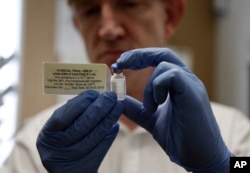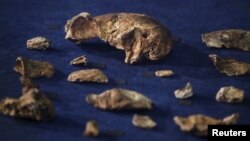Gene-editing technology called CRISPR topped this year's Breakthrough of the Year list compiled by Science magazine.
Although the technique has been around for a few years, in 2015 researchers made CRISPR easier, faster and cheaper to use, heralding an era that holds great promise for fixing damaged genes or eliminating pests that carry disease. In a Science magazine podcast, Science deputy news editor Robert Coontz reported on several experiments using CRISPR, including its potential to alter genes in mosquitoes to stop malaria.
"So you can change not just one organism at a time, but through its offspring you can make the changes spread to future generations and, eventually, if you do things just right, you can arrange things so that they will dominate the whole population," he said. "Or, in another malaria mosquito work, they made all the females infertile."
CRISPR may also be deployed to repair or replace mutated genes that cause disease, help save endangered species, or even bioengineer trees to ferment into biofuels.
But over the year, the work has raised considerable debate over ethics that must be considered before the techniques can be applied outside the lab.
Ebola vaccine and Pluto pictures
In other health news, scientists discovered that the lymphatic system, which transports waste and immune cells in the body, extends to the brain. The new work could lead to devising therapies for neurological diseases such as Alzheimer's.
Also this year, yeast was engineered to make opioid painkillers. And, in the wake of the Ebola epidemic that took 11,000 lives in West Africa, a new vaccine to fight the virus proved effective in monkeys. In human clinical trials, it proved between 75 percent and 100 percent effective.
From the human body to outer space, Science magazine calls 2015 a big year for small worlds. In July, the New Horizons zeroed in on Pluto after a 9½-year, 5-billion kilometer journey.
The high-resolution photos revealed huge mountains of water ice lodged in vast plains of frozen nitrogen and methane. Earlier in the year in a separate NASA mission, the spacecraft Dawn got a close-up look at Ceres, a dwarf planet located in the asteroid belt between Mars and Jupiter.
"It's really dark, but it has these bright spots that no one can really identify," Coontz says. "It is possible that there is an ocean down underneath, the way some of the moons of Jupiter and Saturn have. And where there are oceans, people say there could be life."
New human species
Also in 2015, a not-yet-dated human species called Homo naledi was discovered in a South African cave. Coontz says the 1,500 bones from 15 individuals appear both human and ape-like.
"Their wrists are kind of modern-looking,” Coontz said. “Their skeleton suggests that they walk upright. But they have small brains. Their fingers were long and curving ... suggesting that they still might be climbing trees."
The analysis is far from done, as the team will continue to search for answers about who these ancients were, when they lived and why, for example, no other animals were found with the remains.
Scientists unraveled another mystery close to Earth's core in 2015.
Huge columns of hot rock from beneath the Earth have the power to create volcanic islands and move tectonic plants. Using a new seismic instrument, scientists learned the deep plumes originate from nearly 3,000 kilometers at the Earth's core, a lot deeper than expected.
They were thicker, as well — about the size of a football field.
"That means these things are pushing a lot more heat out of the center,” Coontz said. “So people who do models of the heat flow inside of the Earth are going to have to take that into account with new models."
Assault of the year
Alongside these breakthroughs in science, the list includes Breakdown of the Year: the destruction of ancient sites and monuments targeted by the Islamic State.















